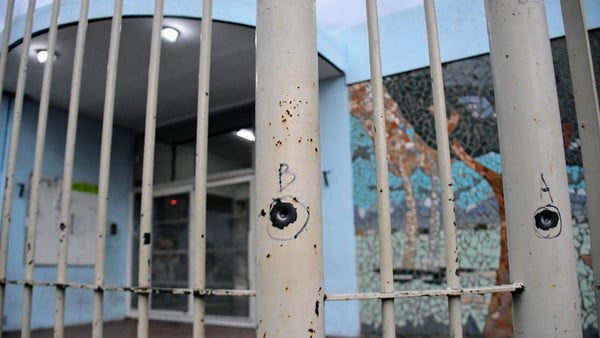Global Courant 2023-05-21 09:01:22
“Your children, your nephews, your neighbors’ children can come to school. How are they going to put something that is important to everyone at risk?” On the other side, the answer was: “I’ll say, stay calm. Nobody is going to mess with the school, the teachers, the cars of those who work at the school or the children who study.”
Those who remember remember that the meeting was in the early 2010s, between the director of a school in the La Granada neighborhood, south of Rosario, and the leader of Los Monos, Claudio “Pájaro” Cantero. It was a kind of “coexistence agreement” that was strictly respected. But in May 2013, Cantero was assassinated. And over time things began to change. To the point that in recent months Rosario’s schools have become the new target of drug bullet attacks.
“The gangs know that these acts gain notoriety. And they are a message of discipline towards society. If we say that the school is what matters most to us in this life, which are our children, they show us that they do not care about anything at all “, explains Martín Lucero, general secretary of the Argentine Union of Private Teachers (SADOP) of Rosario.
Marcelo Vásquez (45) is a third grade teacher. He has worked in the education sector since the late 1990s. He remembers: “Before, you would put on your overalls and go into any territory to look for a kid who was often missing. One would relax with the imaginary of the teacher, the school, the teacher. It was synonymous of respect in the neighborhoods. That has faded. Today you have to be careful and use certain devices to walk through these places.”
The most serious event occurred on April 18. A manager of a textile company was attacked while he was getting out of his truck to drop off his son and a friend at the Medalla Milagrosa school in the Alberdi neighborhood, in the north zone. The victim was shot twice in the face; the truck, seven. Students and parents were witnesses and ran desperate through the streets around the school.
The marks of the shots at the Estanislao López school, in the Belgrano neighborhood of Rosario, shot on Thursday night. Photo Juan Jose Garcia
The last shooting was Thursday night. The ammunition hit the bars in front of the Estanislao López school, in the Belgrano neighborhood, to the northwest. Although it is worth clarifying: it is not known if they were in the context of a shooting, or if the objective was a person and their aim failed.
“The other day a teacher told me that a third grade boy told her ‘Señor, I already know what to do if there is a shooting,'” says Lucero. And he adds: “The boy threw himself on the floor, under a table. These issues are part of the daily life of our students. That is why they are dealt with; they come out on their own. The school is not a bubble in which we limit ourselves to teaching the tables. We constantly live in a Netflix series. Everything we see in fiction here we really suffer.”
Vasquez shares an image of an activity describing the lives of her third graders. The slogan was “When we are in danger and we feel scared or threatened, what makes us afraid today?”. One of them replied: “Big things, insects, height, getting hurt and shots.” And he tells an anecdote not recorded in the notebook: another student who told him about a homicide in the corner of his house. “Profe, they killed him with a 9 (for the 9-millimeter weapon)”, he described to him, with the precision of the one that he hears about calibers or knows the difference between a pistol and a revolver.
Martín Lucero, secretary of SADOP, says that they address the problem of violence in the classroom. Photo Juan Jose Garcia
“We approach these problems from the pedagogical point of view”, clarifies the teacher. “It is very dramatic, very cruel. Putting into words what happens to them, and that it can be shared, and problematized, helps these episodes not become natural. I often use literature as a trigger for themes.”
Statistics state that 33 of the 287 homicides in 2022 had minors as victims. Most were not involved in the crime. They were killed for being in the wrong place. “Enough of killing our students”, is one of the requests in the teacher protests. Another of the consequences, say the professionals consulted by Clarín, is that many of the boys from the popular neighborhoods grow up locked up. They practically only leave their homes to go to study. Going to the neighborhood square means running the risk of being caught in the middle of a shootout between gangs.
The response of a third grade student in a school activity. The boys are afraid of the shots.
“We are not aware of boys who have dropped out due to school shootings. What we do notice is that in the face of each incident, a part of the educational community takes several days to return to classes. Given this, the school’s message is of peace of mind. If we live in fear of going to school, we are facing a big problem,” says Lucero.
But parents and students are not the only ones who are afraid to go to school. Teachers feel it too. According to a survey carried out by SADOP, and in which 544 teachers from the province of Santa Fe participated, 7 out of 10 professionals claimed to have been afraid of going to teach and close to 90% claimed to have heard of colleagues or students assaulted near schools. .
Towards the end of April, the Ministry of Security of the Province presented the “I accompany you” plan. This is a security or prevention device in city schools that were the scene of acts of violence. “They are circuits: a patrol car runs through the vicinity of three or four schools in each neighborhood at the time of entry and exit. The same in bus stops in which teachers and students travel,” clarifies the Minister of Security, Claudio Brilloni.
“Some establishments have an anti-shooting protocol,” resumes Lucero. It is not something endorsed by the Ministry of Security, but decided by each school. Clarín agreed to the protocol of a school in the southern zone. There it is read that the staff “must remain in the classroom, face down and away from doors and windows” and that for “no reason should the school be evacuated.” There is also a striking fact in this time when everything goes viral: “Do not take pictures or videos of the event.”
“It is a sequential scheme: if there are shootings, the doorman opens the doors for those who feel insecure to enter to take refuge. The other possibility is to close the entrances. But so far we have no records of specific attacks on schools. They are shootings in the immediate vicinity of the school, but not against the school itself.
Lucero clarifies that within the framework of the “I accompany you” measures, there are schools that have a patrol car at the door. Some teachers refuse. First, because they feel that the school is starting to resemble a police station. Second, because it has gone from patrol cars shot. Although in other contexts, far from establishments.
On Wednesday, Clarín toured the northern part of the city. In those days the violence had moved to La Cerámica, the neighborhood where the world champion Ángel Di María grew up. It all started with the arrest of a drug dealer. His house was left alone. And it is said that someone would have passed the information: the narco kept 10 kilos of cocaine inside an air conditioner.
The robbery was not long in coming. In Rosario, each kilo of cocaine costs, on average, 5,500 dollars. “The problem is that he would not have paid for the shipment,” warns an investigator from a federal force. “He is desperate. The rumor is that the drugs would be from Los Monos. And this guy has to pay for it no matter what. He sent word that the shots will continue until they return the drugs.”
The perpetrators of some of those shots murdered a couple of teenagers: Máximo Luján (14) and Maite Gálvez (15). They were students from the República del Uruguay school, from La Cerámica. This newspaper witnessed how a member of the Santa Fe Police relieved the schedules in the schools in the area to designate the police instructions. “Every day we ask the time of entry and exit of the boys to leave a patrol car in commission. In this case it is at 8:30 and 17:30,” said the police officer. Minister Brilloni details: “It is a complementary measure for schools that ask us for special protection.”
Although there is no record of students who abandoned their studies due to shootings, there are causes linked to the world of drug trafficking for which several boys stopped studying. One reason is moving. Families who are afraid of life in their neighborhoods and decide to move. At least for a time. Others leave by force directly, due to threats from the gangs who want their houses to use as shelters. But there is still a crueler reason. Vásquez, the teacher, calls it a “criminal economy.”
And he says about it: “Our students are easy prey for the gangs. They are between 12 and 16 years old. They use them and discard them when they want. Many die young. It is the culture that drug trafficking generates: quick access to easy money and the status generated by moving with a weapon at the waist. It’s an unequal fight with what we propose. We’re talking about kids who got to know the Monument to the Flag for a school activity, or who don’t have drinking water. We feel unease and impotence when the Narco wins us a kid. But we do not give up. It is an ethical commitment: the school must be the place where they recover their childhood and we take care of that sense of childhood. Violence cannot be naturalized”.
Rosary beads. Special delivery
AS








